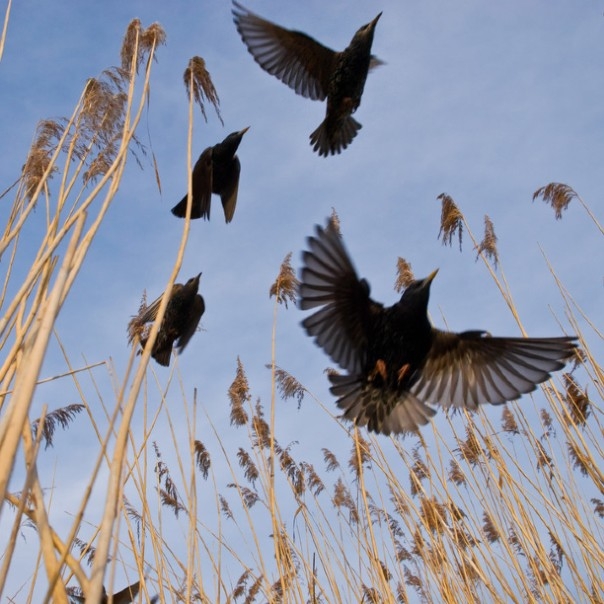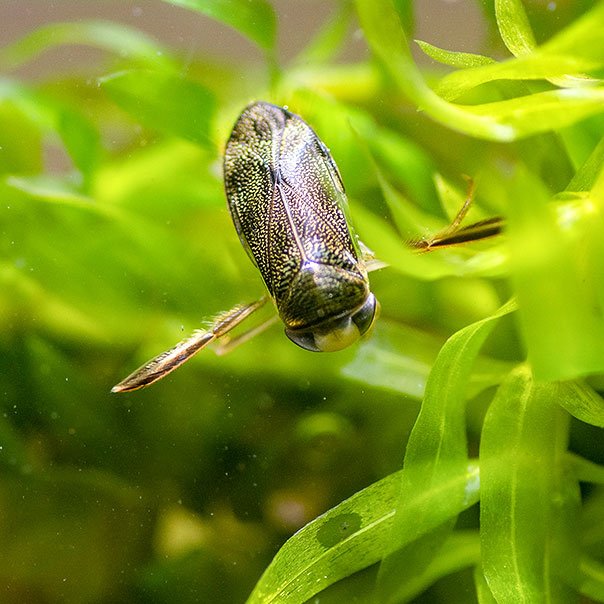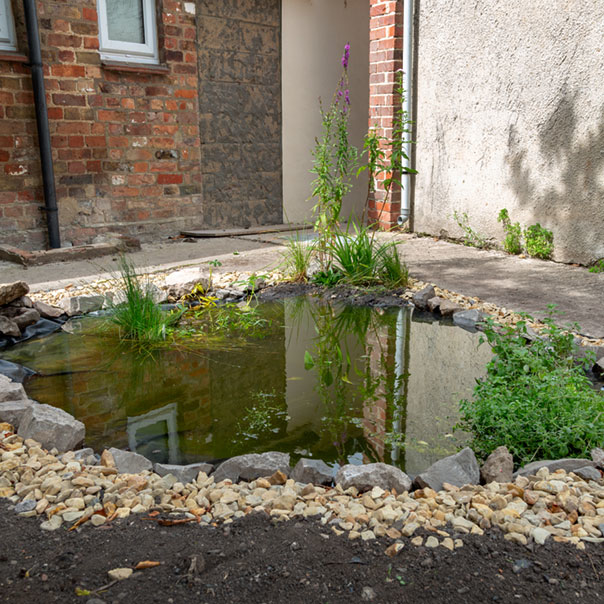Ponds
Discover a miniature freshwater world that supports hundreds of species.
Look into the depths of a pond in the springtime and you will be amazed at the abundance of life you see there. Ponds support a wide range of plant and animal life.
Whether they’re natural or man-made, these essential freshwater habitats support an incredible two-thirds of all freshwater species. Creating and restoring healthy ponds is one of the simplest and most effective ways to protect biodiversity.
Ponds support two-thirds of all freshwater species.
Introduction to ponds
What is a pond?
A pond is a body of water (normally fresh water, but occasionally brackish), which can vary in size between one square metre and two hectares (about the size of two and a half football pitches), and which holds water for four months of the year or more. Many ponds have been created by people, however, there are plenty of examples of ponds that have been sculpted by nature: by meandering rivers, eroding glaciers, a tree falling over leaving the root pit exposed or even by animals, such as beavers or wild boar.
Where do you find ponds?
Ponds are found in gardens, towns and villages, in the countryside, on farmland, in floodplains and heathlands, in woods, on grasslands and on moors. They are often defined by where and how they’re formed.
A beaver pond is one that’s formed by the animal’s natural damming activity. But they’re not the only species that can form ponds – crocodiles, wild pigs, hippos and even cattle are good at it too.
A kettle pond is a naturally formed hole that occurs when a melting glacier or retreating water after a flood leaves a shallow depression filled with sediment.
Ephermal ponds, are special because they dry out at certain times of the year. Because of this, they’re usually absent from fish, which makes them ideal habitat for tadpole shrimp and natterjack toads. Cattle can form mini ephemeral ponds by repeatedly walking over wet grasslands where the tadpole shrimp eggs are lying dormant. The shrimp hatch and breed in this freshwater hideaway until they dry out again.
Farmland ponds were historically very popular as a water supply for thirsty livestock, but few people realised what a positive effect they had on biodiversity until recently. Many were neglected or filled in to make space for agriculture.
What lives in a pond?
Ponds support two thirds of all freshwater species. They’re so important because many species can only survive in this particular habitat. The wildlife you’re likely to see in and around ponds includes; amphibians (common frog, common toad, and great crested newt), invertebrates (common great diving beetle, blue-tailed damselfly, and water boatmen), fish (including minnows and the 10-spined stickleback), plus a variety of bird life. You might even see Daubenton’s bat feeding on insects in the twilight, or hobby raptors hunting dragonflies on the wing.
Small garden birds use ponds for drinking and bathing, and some larger ponds may attract swans, ducks, moorhens and even unusual visitors such as lapwings, redshanks and snipe.
At WWT Caelaverock we have a very special pond dweller in residence. The triops, or tadpole shrimp, were once only thought to survive in seasonal ponds in the New Forest but we discovered a new colony in a small pool on our reserve in 2004. Since then we’ve supported this rare species which can now be found in 10 or 12 different ponds – and we’re discovering new ones all the time.
80% of the UK’s ponds are found in gardens.
Why we need ponds
Ponds are important hotspots for biodiversity. Collectively, they support more species, and more scarce species, than any other freshwater habitat. Ponds are essential habitats for wetland wildlife. Healthy networks of ponds, at different stages of their ‘lives’, help wetland species to move around the countryside, supporting ‘nature corridors’. As habitat fragmentation continues to increase, they are more important than ever. Without them, many native species would struggle to survive.
Ponds support more rare species than any other freshwater habitat
Ponds in our culture and history
For centuries, ponds were an essential part of people’s lives and nearly every village and farm in Britain had a pond. In some parts of the UK it wasn’t uncommon to have four or five ponds in one field. The water was used by both humans and animals but as technology advanced and water became available at the turn of a tap, many ponds were neglected.
The transcendentalist Henry David Thoreau’s book ‘Walden’ was a document of his experiences living next to a famous kettlehole. Published in 1854, the book was seen as an experiment to see if humans could strip away modern enjoyments for a simpler life in nature.
Ponds play an important role in maintaining the link between people and wildlife, both in urban areas and in the countryside.
Threats to ponds
Less than 70 years ago, ponds were a common feature of the landscape, and were routinely managed just like hedgerows. Due to changes in agriculture and rural lifestyles the creation and maintenance of ponds has become a thing of the past. In the UK, pond numbers declined from approximately 800,000 in the nineteenth century to 200,000 by the 1980s.
Since most ponds were man-made, when abandoned by humans they were taken over by nature; plants at the edges took over where there were no farm animals to trample them down and some ponds ended up as marshy bogs. Fallen leaves choked ponds and the oxygen vital for pond life, was used up as they decayed. Other ponds have been destroyed by pollution or drained.
Today we are rediscovering the importance of ponds in our landscape. Whilst some ponds have been filled in to increase land for agriculture, creating ‘ghost’ ponds, others have simply not been cared for and so have become areas of overgrown scrub.
Protecting ponds
What is WWT doing to protect ponds?
We have been working to provide evidence of the multiple benefits of farm ponds. This research shows clear links between the management of farmland ponds and thriving populations of farm birds. The Conservation Evidence team have been using historical maps to identify older, forgotten ponds and identify areas that are key to maintaining a healthy pond network. We have been providing guidance and funding for farmers interested in restoring and creating ponds on their land, and helping them to become advocates for nature-friendly farming.
What can you do?
Creating a pond is one of the most important things you can do for wildlife in your garden. It is vital habitat for wetland wildlife like frogs and dragonflies. It’s also great for many species of garden plant, insect, bird and mammal.
Find out how to build your own wildlife pond
Fancy a spot of pond dipping?
Read our guide to pond dipping to find out the things that you should know before you go.
You might also be interested in
WWT creates, protects and restores wetlands for wildlife and people, including ponds, at our sites across the UK and internationally.
Support WWT

